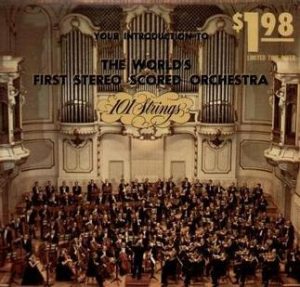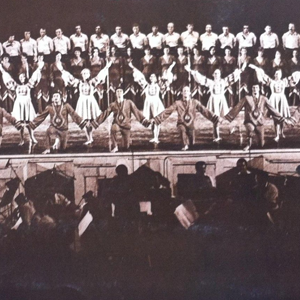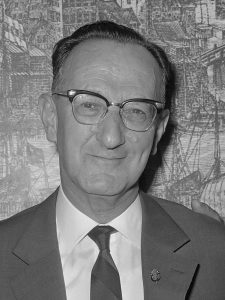
101 Strings Orchestra was a brand for a highly successful easy listening symphonic music organization, with a discography exceeding 150 albums and a creative lifetime of around 30 years beginning in 1957. 101 Strings had a trademark sound, focusing on melody with a laid-back ambiance most often featuring strings. Their LPs were individualized by the slogan “The Sound of Magnificence”, a puffy cloud logo and sepia-toned photo of the orchestra.The 101 Strings orchestra included 124 string instruments, and was conducted by Wilhelm Stephan. The orchestra’s famous official photograph was taken in the Musikhalle Hamburg.
Record label mogul David L. Miller came to prominence by releasing the first Bill Haley & His Comets’ records in 1952–1953 on his own Essex label (followed by Trans-World, then Somerset Records). In this capacity, Miller played a role in the creation of rock and roll.
Following the rise of mood music (practitioners Mantovani and Jackie Gleason Presents), Miller subcontracted the Orchester des Nordwestdeutschen Rundfunks Hamburg (the Northwest German Radio Orchestra of Hamburg) conducted by Wilhelm Stephan to play in-house arrangements of popular standards. The first three 101 Strings albums were released in November 1957, and twelve more titles were released in 1958 (many of which featured recycled material from earlier albums attributed to the New World Orchestra, Rio Carnival Orchestra, and other light music orchestras). These records were pressed by Miller’s own plants and released through his own distribution channels (such as grocery stores).
In 1964, Miller sold the franchise to Al Sherman, a successful record label distributor, who renamed the label Alshire (based in Los Angeles) and moved recording to London. Sherman retained Miller as a partner to oversee production and A&R. The Alshire era is characterized by large-scale expansion of product, attempts to branch out to younger markets and beginning in 1969, eventual stagnation (although late efforts by Les Baxter and Nelson Riddle were released under the 101 name in 1970). Output decreased from 1974 on. A tribute to John Lennon (composed of earlier Beatle tribute material – 101 Strings play Hits written by The Beatles) in January 1981 marked the final 101 Strings effort.
Many 101 Strings albums are simply orchestrated versions of pop hits and show tunes, although the early Somerset material contains many examples of the exotica and lounge genres. Songs of the Seasons in Japan, Hawaiian Paradise, and East of Suez are three such albums. 101 Strings Play the Blues and Back Beat Symphony were early experiments in symphonic-pop hybridization, while Fly Me To The Moon contains five noir-ish originals. Alshire releases include ‘Now Sound’ albums such as Jet Set, Sounds of Today, and Astro-Sounds from Beyond the Year 2000, the last of which has been frequently sampled by electronic music artists of the 1990s and 2000s (decade).
His core staff arrangers were Monty Kelly, Joseph Francis Kuhn, and Robert Lowden. All three proved adept at writing original compositions that were stylistically consistent both with contemporary hit songs and each other. Miller placed these on 101 Strings albums to provide additional publishing revenues.
Kelly’s earliest successes were Latin and Spanish travelogues (such as the “Soul of Spain” series), although he became 101 Strings’ “Now Sound” specialist following the British Invasion. Kuhn concentrated on radio-friendly numbers in the “Pops”‘s orchestral manner (“Blues Pizzicato”, etc.) which provided Somerset its initial catalog of originals. Lowden composed lounge ballads (such as “Blue Twilight”). Their body of early 1960s work was recycled via re-release throughout the next twenty years.
The Alshire catalog was sold to Madacy, Inc. in the 1990s and, under the direction of Greg Sims, a “New 101 Strings Orchestra” began releasing a series of CDs (including a two-volume Beatles set). 101 Strings compilations were reissued on CD during the “lounge revival” of the 1990s. Few 101 Strings LPs have been re-released in their original form.
If one goes to the Madacy site to view their 101 Strings collection, exactly the same description that was used on the Bel Canto’s ST- 76 two track stereo release about the 101 Strings sound is reprinted. The 50 Hz hum heard on many of those tape recordings was due to the Ampex 350’s filtering which was not well suited for European 50 Hz power. The “My Fair Lady” and “King and I” releases have what appears to be the sound of dirty mixing pots used on the fly during those sessions. There were a number of tape releases that sounded like tape copies of pristine Stereo Fidelity vinyl which actually, were not all that pristine. Stereo recordings were made with a triangular cutting stylus. This resulted at times in pinch distortion which early conical styli did not handle well. Inner grooves especially, due to the increased density of the recorded information due to the slower relative movement of the track under the stylus, were more susceptible to distortion with conical styli in use at the time this record was released. The later development of elliptical styli allowed more precise tracking of the track and greatly reduced inner-track distortion.
In the 10 years and 2 months of their existence, 101 Strings sold over 50,000,000 records worldwide.
The Barry Sisters
 The Barry Sisters were a Jewish pair that recorded hundreds of Yiddish songs. Originally known as the Bagelman Sisters, they were the most popular singers in the genre called Yiddish Swing, which popularized and jazzified Yiddish folk songs. They also sang popular tunes with Yiddish lyrics (e.g. “Raindrops Keep Falling on My Head”).
The Barry Sisters were a Jewish pair that recorded hundreds of Yiddish songs. Originally known as the Bagelman Sisters, they were the most popular singers in the genre called Yiddish Swing, which popularized and jazzified Yiddish folk songs. They also sang popular tunes with Yiddish lyrics (e.g. “Raindrops Keep Falling on My Head”).
Let it not be forgotten that the Barry Sisters not only form an important link between the past and present of Yiddish song but moreover brought songs of Yiddish songwriters to a wider mainstream audience than probably anybody before. Their tremendous abilities – as international pop singers, a hugely successful sister act, and two fun, charming beauties – quickly led to international stardom.
Their career spanned close on half a century, from the post-depression years to the 1970’s. The Barry repertoire included songs in nine languages. They were often featured on the New York radio show “Yiddish Melodies in Swing” and also crossed over into the mainstream as well, appearing on American TV programs such as “The Ed Sullivan Show” (10 times, from 1956 to 1965), “The Jack Paar Show” and “The Tonight Show”, in addition to being mainstays at top nightspots in several countries. They also were among the few performers to tour the former Soviet Union, and came to have a large following from that country, as well many other places in the world.
Claire, with the higher voice, is still active and performing. Her sister Myrna, with the lower voice, passed away in 1976. Enjoy the rich voice and the good humour of the Barry Sisters!
David “Dudu” Fisher
 David “Dudu” Fisher (born November 18, 1951;) is an Israeli cantor and stage performer.
David “Dudu” Fisher (born November 18, 1951;) is an Israeli cantor and stage performer.
He is best known for his Broadway performance as Jean Valjean in the musical Les Misérables.
Cantorial career
The son of a Holocaust survivor, Fisher was born in Petah Tikva, Israel. He began studying at age 22, after the Yom Kippur War and his discharge from the army following 3 years of service. Fisher studied at the Tel Aviv Academy of Music, and studied privately under famous cantor Shlomo Ravitz. He then took up the cantorial position at the Great Synagogue in Tel Aviv, followed by 4 years in South Africa. For over 20 years, Fisher was the cantor at Kutsher’s Hotel in the Catskills during the Jewish high holidays. In 2005 Fisher became the Chief Cantor of New York Synagogue.
Les Miserables
After being mesmerised by the London performance of the 1980s hit musical, Fisher, despite no prior acting experience, requested the part in a Hebrew production of Les Misérables. He played its leading role, Jean Valjean, in Israel from 1987 to 1990, and made local fame.
He played the role on New York’s Broadway during the winter of 1993-4, and later at London’s West End, where he was invited to perform before Queen Elizabeth II. At both venues, Dudu was the first performer excused from Friday night and Saturday performances, as he is an Orthodox Jew and was not able to perform because of the Sabbath.
Other performance roles
Among Fisher’s other performances is his one-man Off-Broadway show, Never on Friday, an anecdotal work exploring the complications of his experience on Broadway as an observant Jew. He performed in many tours around Israel, the United States, and the world, particularly in Jewish communities, performing classics, as well as musicals, such as Over the Rainbow which toured Israel with Fisher performing 40 Broadway show tunes.
He performed for United States President Bill and Hillary Clinton, and for Britain’s Royal family, and the Thai Royal family.
He has also performed with the Israel Philharmonic Orchestra, conducted by Zubin Mehta, with a performance televised in France, and with the Baltimore Symphony Orchestra and the Queens Symphony Orchestra. He has recorded an album of show tunes with the London Symphony Orchestra. He was the first Israeli artist allowed to sing in the Soviet Union before perestroika.
Discography
In addition to his stage and synagogue performance, Dudu Fisher has released over 25 albums, including songs in Hebrew, Yiddish, and English, many classics and cantorial pieces, as well as music for children. He also sang the part of Moses in the Hebrew version of Steven Spielberg’s animated film, The Prince of Egypt.
- Hatikvah (2005)
- Lehitei Yiddish Beivrit (Yiddish hits in Hebrew) (2005)
- Coming to America (2004)
- Prayers On Broadway (2003)
- Songs Of My Heart (2002)
- Mamenyu (2001)
- Odecha (1999)
- L’tav Ulchayim V’lishlam (For Good, For Life & For Peace) (1997)
- Never On Friday (1996)
- Az Yashir David (1996)
- Beshem Hashem (In God’s Name) (1994)
- Showstoppers (1994)
- The Malavsky Family Songs (1993)
- Mamma Loshon (Mother Tongue) (1992)
- Velvet Tiger (1992)
- Golden Chasidic Song (1992)
- Gift (1992)
- Tonight, A Musical (1991)
- Stairways To Heaven (1990)
- Over the Rainbow (1989)
- Yiddishkiet (1988)
- Elokai Neshama (1985)
- Golden Yiddish Favorites (1985)
- Childhood Years
- Raisins and Almonds
- Songs Of The Living
- Yiddishe Mamme
- Dudu Fisher’s Kindergarten (DVD/VHS):
- (1998)
- We Are All Friends (2000)
- From The Heart And Soul (2001)
- The Friendship Trip (2002)
- It’s The Thought That Counts (2003)
- From The Mouth Of The Infants
- Shabat Shalom
- Shana Tova
- And Thou Rejoice In Thy Feast
Connie Francis
Born December 12, 1937
Connie Francis was born Concetta Rosa Maria Franconero in the Italian Down Neck, or Ironbound, neighborhood of Newark, New Jersey. She is considered the most prolific and popular female rock ‘n’ roll hit-maker of the early rock era — the late 1950s to the early 1960s. After an appearance on Ford Startime, Francis was advised to change her name from Franconero to something more easily pronounceable — as well as to quit the accordion and focus on singing.
Francis’ first single, “Freddy”, (1955) met with little success. Her next nine singles were also failures, and she began to consider a career in medicine. However, a cover version of the song “Who’s Sorry Now?” (1923) by Bert Kalmar and Harry Ruby launched Francis into super-stardom worldwide. She recorded the song at what was to have been her final recording session for MGM; the label was about to drop her owing to her previous singles’ poor sales. Francis has said that she recorded it at the suggestion of her father, who convinced her it stood a chance of becoming a hit because it was a song adults already knew and that teenagers would dance to if it were released with a more contemporary arrangement.
The gamble paid off. On January 1, 1958, the song debuted on Dick Clark’s American Bandstand television show, and by mid-year over a million copies were sold. In April 1958, “Who’s Sorry Now” reached number one on the UK Singles Chart and number four in the USA. This was followed by many other hits over the next decade, as Connie Francis became one of the most popular vocalists in the world.
As Francis explains at each of her concerts, she began searching for a new hit immediately after her 1958 single Who’s Sorry Now? became a success. She was then introduced to Neil Sedaka and Howard Greenfield, who played every ballad they had written to date, for Connie. After a few hours, Francis began writing in her diary while the two songwriters played the last of their ballads. After they finished their last song of the session, Francis told them that they wrote very beautiful ballads but that she considered them too intellectual for the young generation of the time. Greenfield then suggested to Sedaka a song they had written that morning for another girl group. Sedaka protested, believing that Francis would be insulted. Greenfield said that she hated all the other songs they had performed and that they had nothing more to lose. Sedaka reluctantly agreed to play Stupid Cupid with Greenfield for Francis. As soon as they finished playing the song, Francis told them that they had just played her new hit record. Francis’ song reached #14 on the Billboard charts. While Francis was writing in her diary, Sedaka asked her if he could read what she had written. After she refused, Sedaka was inspired to write The Diary, which was his first hit single. Through the rest of her early career Sedaka and Greenfield wrote many of Connie Francis’ hits such as Fallin and Where the Boys Are.
Connie specialized in downbeat ballads (often remakes of old standards) delivered in her trademark “sobbing” style, such as “My Happiness”, “I’m Sorry I Made You Cry”, “Among My Souvenirs”, “Together”, “Breakin’ In a Brand New Broken Heart”, and the Italian song “Mama”. However, she also had success with a handful of more upbeat, rock-and-roll-oriented compositions, such as “Stupid Cupid”, “Lipstick On Your Collar”, and “Vacation”.
Among Francis’ other notable performances were “In the Summer of His Years” (a tribute to slain U.S. President John F. Kennedy) and Bert Kaempfert’s “Strangers in the Night” (although the latter song is more often identified with Frank Sinatra). Both “Everybody’s Somebody’s Fool” and “My Heart Has a Mind of Its Own” went to number one on the Billboard music charts in 1960. In 1962, Francis had another number one hit with “Don’t Break the Heart That Loves You”.
Francis remade many of her hits in foreign languages, including “Everybody’s Somebody’s Fool” and her signature song, “Where the Boys Are”. Francis recorded in thirteen languages throughout her career: English, German, Swedish, Dutch, French, Spanish, Portuguese, Italian (and its dialect Neapolitan), Hebrew, Yiddish, Japanese, Latin and Hawaiian. During a concert at the Golden Stag Festival in Brasov, Romania in March 1970, Francis performed live in Romanian. Francis’ biggest hit album in the U.S. was 1959’s Italian Favorites; she followed it with several more albums of Italian songs over the years, as well as collections of Spanish-language and Jewish songs, among others.
In the 1960 motion picture Where the Boys Are Connie was able to highlight her acting talents to a broader range of audiences. During the first half of the 1960s, she starred in three additional films: Follow the Boys (1963) (the title song of which became a No. 17 Billboard single for Francis), Looking for Love (1964), and When the Boys Meet the Girls (1965).
In 1960, Francis became the youngest headliner to sing in Las Vegas, where she played 28 days a year for nine years. In 1961, she starred in her own television special on ABC television sponsored by Brylcreem titled Kicking Sound Around, singing and acting alongside Tab Hunter, Eddie Foy Jr. and Art Carney. Francis appeared on the Ed Sullivan Show on July 1, 1962 with French singing star Johnny Hallyday in a show that was taped at the famous Moulin Rouge nightclub in Paris, France. On July 3, 1963, she played a Command performance before Queen Elizabeth II at the Alhambra Theatre in Glasgow, Scotland. By 1967, Francis had 35 U.S. Top 40 hits, three of which were number ones. During the height of the Vietnam War in 1967, Connie Francis performed for U.S. troops. Francis ended her recording career in 1969. She returned in 1973 with “The Answer”, a song written just for her, and soon began performing again.
Francis has always been a great fan of country music, and recorded several albums of country standards during her pop career. In 1969, she had a modest country hit with, “The Wedding Cake.” She appeared on the country charts again in 1982 with “There’s Still a Few Good Love Songs Left in Me.” Several country singers found chart success remaking Francis’ pop hits for the country market, including Marie Osmond (“Who’s Sorry Now” in 1975), Susan Raye (“My Heart Has a Mind of Its Own” in 1972), Margo Smith (“Don’t Break The Heart That Loves You” in 1978), and Debby Boone.
Francis’ autobiography, Who’s Sorry Now? was published in 1984.
In 2000, “Who’s Sorry Now” was named one of the Songs of the Century. Her latest CD The American Tour contains performances from recent shows. In late December 2004, Francis headlined in Las Vegas for the first time since 1989.
In March and October 2007, Francis performed to sold-out crowds at the Castro Theater in San Francisco.
Source: Wikipedia
The Irving Fields Trio
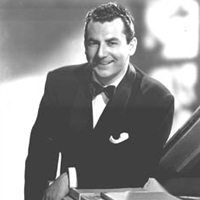 Trained in the prime years of Tin Pan Alley and immersed in the classic American popular music of the pre-World War II era, IRVING FIELDS is simply one of the last of a truly special generation who continues to perform to this day.
Trained in the prime years of Tin Pan Alley and immersed in the classic American popular music of the pre-World War II era, IRVING FIELDS is simply one of the last of a truly special generation who continues to perform to this day.
Capturing the career of Irving Fields would require an immense effort. His “lounge” credentials place him at the top of pianists who played NYC’s finest hotels and society rooms. His piano trio recordings celebrate this aspect of his work. Then there are his legendary solo cocktail piano skills that allow him to play “any request” from the audience and seamlessly string together snippets of tunes from disparate eras and syles to form masterfully flawless medleys. One cannot forget his seminal compositional and arranging work that joined Latin, jazz and popular music, resulting in such international hits as “Miami Beach Rhumba” and “Managua Nicaragua.” In addition, his series of world fusion records that artfully combined Latin rhythms with Jewish music (Bagels and Bongos), Italian music (Pizza and Bongos), French music (Champagne and Bongos) and Hawaiian music (Bikinis and Bongos) remain immortal ’50s period pieces and influential precursors to today’s world fusion.
Irving Fields grew up on the Lower East Side of New York City. His first piano lessons came at 8 years old, and he was the only one of six children to complain about practicing. However, at age 15, Irving won the Fred Allen Radio Amateur Hour and was given a week engagement at the Roxy Theater. Entrance into the prestigious Eastman School of Music followed as did classical piano engagements and cruise ship appearances. His biggest signature style developed when, at eighteen and earning $10 a week, a cruise ship job brought him to Havana and San Juan. Irving was hooked on Latin music. He brought it back to New York to form a trio and later an octet, and found work at the Savoy Lounge in New York’s Plaza Hotel. New York was discovering Latin rhythm, thanks to great bands like Xavier Cugat’s, and this young man from the Lower East Side.
In 1941, Irving was drafted into the army and wound up in Fort Dix, New Jersey, to await his fate. As thousands of inductees were standing around on a steamy-hot summer day waiting for the general to show up, a captain yells, “Can anyone here entertain?” Sure enough, Irving obliged. After the general showed up, the captain told Irving, “I’m putting you in Special Services” — entertaining the troops. Irving was able to form an ethnically diverse Latin group, and spent his army tenure having the good fortune of entertaining.
While on leave in Florida, Irving met an agent who booked bands for several Florida hotels, who made Iriving promise to contact him upon his discharge. Sure enough, Irving did so. At Miami’s Versailles Hotel, with Latin music the rage, he formed another eight-piece orchestra and began a career in hotels that continues to this day. During his stay in Miami, Florida, Irving wrote one of his most popular tunes, “Miami Beach Rumba.”
Back in New York City in the late ’40s and into the ’50s, Irving worked at the Crest Room on East 56th Street, and continued in the Latin style with a trio. He met Cugat there, who at first spoke to Irving in Spanish. Irving said, “Mr. Cugat, I’m not Spanish, I’m American. I know Spanish songs but I don’t know the language.” Cugat was shocked, but offered Irving a job with his band. Irving, however, decided to decline and stick to his trio.
Irving’s agent, Leonard Green, brought in an RCA Victor representative to listen to Fields’ band and he was soon signed to his first recording contract, billed as the Irving Campos Trio (campos means fields in Spanish). Recording a mixture of popular, Latin and classical music, Irving took “Poet and Peasant Overture” and played it as a rumba — it became “Poet and Peasant Rumberture,” classical and jazz. He also recorded “Miami Beach Rumba,” which sold over 2 million copies. Within several months, Irving was making the Billboard, Variety and Cashbox top ten most popular trio lists. From there, everything opened up. Irving appeared on the Milton Berle, Kate Smith and Jackie Gleason shows, at the Roxy Theatre, London Palladium and the Eddie Cantor show in Las Vegas, and at Carnegie Hall (New York) and Symphony Hall (Boston, MA).
Fields left RCA after a dispute involving the type of music he should record, and he began to produce his own music. While working in Boston, Irving heard a local Jewish radio program with beautiful melodies. He decided to try them with a Latin tempo. Fields brought his bongo player, bass player and drummer into a Boston recording studio, took the demo to Decca Records, and was offered a lucrative contract.
In a Boston deli, he was asked what he planned to title the album of Jewish favorites. It struck him in the middle of a bite of his bagels-and-lox sandwich: Bagels and Bongos. Decca prompted Fields to expand on the successful formula and Pizzas and Bongos, Champagne and Bongos and Bikinis and Bongos were born. He had also written and recorded “Managua, Nicaragua,” “Chantez, Chantez,” “Take Her To Jamaica,” and an album titled Children’s Favorites, which included “Who Put The Banana In The Piano?” and “The Purpose of the Porpoise.”
In the days when many New York hotels did live radio broadcasts, Fields found a home at the Park Sheraton, and stayed for 16 years. Tired of travelling and touring to promote his records and with dance music fading, he became a solo pianist. He has been and remains a fixture in Manhattan hotels since, including performing at the Plaza Hotel for 8 years, the Sheraton for 3 years, the Intercontenental Hotel for 1-1/2 years, the Park Lane Hotel for 2 years, and 4 summers at the Hudson Valley Resort. Still performing to this day, Irving can be found at local New York City cabarets, restaurants and rooms, where he continues to entertain and delight music fans of all ages.
Gordon Jenkins
1910 – 1984
Gordon Hill Jenkins (12 May 1910 – 1 May 1984) was an American arranger who was an influential figure in popular music in the 1940s and 1950s, renowned for his lush string arrangements. Jenkins worked with the Andrews Sisters, Frank Sinatra, Louis Armstrong, Judy Garland, Nat King Cole and Ella Fitzgerald, among other singers.
Jenkins was born in Webster Groves, Missouri. He started his career doing arrangements for a St Louis radio station. He was then hired by Isham Jones, the director of a dance band known for its ensemble playing, and this gave Jenkins the opportunity to develop his skills in melodic scoring. He also conducted The Show Is On on Broadway.
After the Jones band broke up in 1936, Jenkins worked as a freelance arranger and songwriter, contributing to sessions by Isham Jones, Paul Whiteman, Benny Goodman, Andre Kostelanetz, Lennie Hayton, and others. In 1938, Jenkins moved to Hollywood and worked for Paramount Pictures and NBC, and then became Dick Haymes’ arranger for four years. In 1944, Jenkins had a hit song with “San Fernando Valley”.
In 1945, Jenkins joined Decca Records. In 1947, he had his first million-seller with “Maybe You’ll Be There” featuring vocalist Charles LaVere and in 1949 had a huge hit with Victor Young’s film theme “My Foolish Heart”, which was also a success for Billy Eckstine. At the same time, he regularly arranged for and conducted the orchestra for various Decca artists, including Dick Haymes (“Little White Lies”, 1947), Ella Fitzgerald (“Happy Talk”, 1949, “Black Coffee”, 1949, “Baby”, 1954), Patty Andrews of the Andrews Sisters (“I Can Dream, Can’t I”, 1949) and Louis Armstrong (“Blueberry Hill”, 1949 and “When It’s Sleepy Time Down South”, 1951).
The liner notes to Verve Records’ 2001 reissue of one of Jenkins’ albums with Armstrong, Satchmo In Style, quote Decca’s onetime A & R Director, Milt Gabler, saying that Jenkins “stood up on his little podium so that all the performers could see him conduct. But before he gave a downbeat, Gordon made a speech about how much he loved Louis and how this was the greatest moment in his life. And then he cried.”
During this time, Jenkins also began recording and performing under his own name. One of his enduring works while at Decca was a pair of Broadway-style musical vignettes, “Manhattan Tower” and “California” which saw release several times (78s, 45s, and LP) in the ’40s and ’50s. The two were paired on a very early Decca LP in 1949), and Jenkins was given the Key to New York City by its mayor when Jenkins’s orchestra performed the 16-minute suite on the Ed Sullivan show in the early ’50s. In 1956, he expanded “Manhattan Tower” to almost three times its length, released it (this time on Capitol Records), and performed it on an hour-long television show. (Both versions of “Manhattan Tower” are currently available on CD.) Another of his long play album productions, “Seven Dreams” included a sequence which was the source for Johnny Cash’s immensely popular recording, “Folsom Prison Blues”.
He headlined New York’s Capitol Theater between 1949 and 1951 and the Paramount Theater in 1952. He appeared in Las Vegas in 1953 and many times thereafter. He worked for NBC as a TV producer from 1955 to 1957, and performed at the Hollywood Bowl in 1964. By 1949, Jenkins was musical director at Decca, and he signed — despite resistance from Decca’s management — the Weavers, a Greenwich Village folk ensemble that included Pete Seeger among its members. The combination of the Weavers’ folk music with Jenkins’ orchestral arrangements became immensely popular, to the surprise of everyone involved. Their most notable collaboration was a version of Leadbelly’s “Goodnight Irene” (1950) backed by Jenkins’ adaptation of the Israeli folk song, “Tzena, Tzena, Tzena”. Other notable songs they recorded together are “The Roving Kind”, “On Top of Old Smokey” (1951), and “Wimoweh” (1952).
Jenkins later moved to Capitol Records where he worked with Frank Sinatra, notably on the albums Where Are You? (1957) and No One Cares (1959), and Nat King Cole, with whom he had his greatest successes; Jenkins was responsible for the lush arrangements on the 1957 album Love Is The Thing (Capitol’s first stereo release, which included “When I Fall in Love”, one of Cole’s best-known recordings), as well as the albums The Very Thought of You (1958) and Where Did Everyone Go? (1963). Jenkins also wrote the music and lyrics for Judy Garland’s 1959 album The Letter which also featured vocalist Charles LaVere, and conducted several of Garland’s London concerts in the early 1960s.
Whilst most of Jenkins’ arrangements at Capitol were in his distinctive string-laden style, he continued to demonstrate more versatility when required, particularly on albums such as A Jolly Christmas From Frank Sinatra (1957), which opens with a swinging version of Jingle Bells, and Nat King Cole’s album of spirituals, Every Time I Feel The Spirit (1958), which includes several tracks with a pronounced beat that might almost be described as rock.
However, as rock and roll gained ascendency in the 1960s, Jenkins’ lush string arrangements fell out of favour and he worked only sporadically, though Sinatra, who had left Capitol to start his own label, Reprise Records, continued to call upon the arranger’s services at various intervals over the next two decades, on albums such as All Alone (1962), the critically-acclaimed September of My Years (1965), for which Jenkins won a Grammy, Sinatra’s 1973 comeback album, Ol’ Blue Eyes Is Back and She Shot Me Down (1981) – regarded by many Sinatraphiles as the singer’s last great work. Jenkins also worked with Harry Nilsson on A Little Touch of Schmilsson in the Night (1973), a collection of pre-rock and roll standards. The Nilsson sessions, with Jenkins conducting, were recorded on video and later broadcast as a television special by the BBC.
Although best known as an arranger, Jenkins also wrote well-known several songs including “P.S. I Love You”, “Goodbye” (Benny Goodman’s sign-off tune), “Blue Prelude”, “This Is All I Ask”, “When a Woman Loves a Man” and “Future”, composed music for Sinatra’s 1979 concept album Trilogy.
Jenkins died in Malibu, California in 1984 at age 73 of Lou Gehrig’s disease.
In November of 2005, Gordon’s son Bruce (a sports columnist for the San Francisco Chronicle) published a biography titled “Goodbye”. Other living relatives include nieces Phoebe Barnum and Leslie Mason.
Gale Kissin
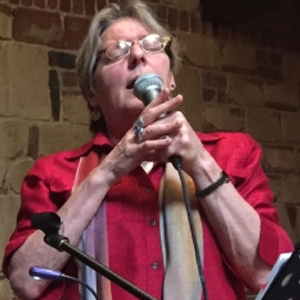 Gale Kissin (Gishe Reyzl) has been singing Yiddish music since before she was fluent in English. In childhood, she was exposed to a Yiddish education in the Workmen’s Circle / Arbeter Ring tradition. Years later, she studied Yiddish at the YIVO Institute and in 2012 co-founded the Sonoma County band Mama Loshn. In 2014, Gale co-founded the first two-day Sonoma County “YiddishLand!” Festival. She has served as Musical Director for the annual Sonoma County-wide Yom HaShoah commemoration for several years, and has stage-managed the Sonoma County JCC’s annual Simcha Sunday. Gale is frequently invited to present workshops, including a JCC Sonoma County-sponsored workshop entitled “Where Did Yiddish Come From and How Do I Put It to Music?” Gale serves on the Sonoma County Jewish Film Festival Committee and is a member of the JCC Sonoma Board of Directors.
Gale Kissin (Gishe Reyzl) has been singing Yiddish music since before she was fluent in English. In childhood, she was exposed to a Yiddish education in the Workmen’s Circle / Arbeter Ring tradition. Years later, she studied Yiddish at the YIVO Institute and in 2012 co-founded the Sonoma County band Mama Loshn. In 2014, Gale co-founded the first two-day Sonoma County “YiddishLand!” Festival. She has served as Musical Director for the annual Sonoma County-wide Yom HaShoah commemoration for several years, and has stage-managed the Sonoma County JCC’s annual Simcha Sunday. Gale is frequently invited to present workshops, including a JCC Sonoma County-sponsored workshop entitled “Where Did Yiddish Come From and How Do I Put It to Music?” Gale serves on the Sonoma County Jewish Film Festival Committee and is a member of the JCC Sonoma Board of Directors.
Maxwell Street Klezmer Band

One of the first klezmer revival bands in the Midwest, the Chicago-based Maxwell Street Klezmer Band has been playing their blend of Yiddish pop tunes, dance music, and Jewish folk songs since 1983. Named after Chicago’s busy marketplace, Maxwell Street Klezmer Band injects horn-driven energy into the music of the past. With guitarist and vocalist Lori Lippitz, co-founder of Yiddish Arts Ensemble and a cantor of the Jewish Reconstructionist Congregation in Evanston, leading the way, the 15-piece group pays tribute to the Klezmer masters while allowing their music to evolve.
Formed in 1983, Maxwell Street Klezmer Band has gone through numerous personnel changes. Only Lippitz and Mintz-born violinist, arranger, and music director Alex Koffman, ex-concertmaster of the Byelorussian Pops Orchestra, remain from the original band. Saxophone, clarinet, and flute player Shelley Yoelin, a professor of music and director of bands at Triton College in River Grove, IL, has been with the group since 1985. As of June 2000, Maxwell Street Klezmer Band features Kimber Leigh Nussbaum (vocals), Donald Jacobs and Jeff Jeziorski (clarinets), Ralph Wilder (clarinet, saxophone, flute), Gail Mangurten and Bob Applebaum (pianos), Sam Margolis and Audrey Morrison (trombones), Ivo Braun (trumpet), David Rothstein (bass), and Mark Ponarovsky and Steve Hawk (percussion).
In 1989, Maxwell Street Jazz Band joined with choreographer Lynn Shapiro to launch a non-profit organization, the Yiddish Arts Ensemble, to present family-oriented theater productions. In 1994, this organization grew into the Klezmer Music Foundation under whose auspices the Klezmer and Yiddish Music Institute, a weeklong series of concerts and workshops, is held annually in the Midwest. The organization also supervises a teenage band, Maxwell Street Junior Klezmer Orchestra.
Since 1996, Maxwell Street Klezmer Band has joined with Peter, Paul & Mary’s Peter Yarrow and Jewish singer/songwriter Debbie Friedman for a Hanukah concert that has attracted an eager audience each year. The band’s peak year came in 1998. They performed in New York at Carnegie Hall’s Weill Recital Hall in February and Lincoln Center’s Damrosch Park in June. In November, they traveled to London, Munich, Vienna, and Amsterdam. ~ Craig Harris, All Music Guide
Jan Peerce
1904 – 1984
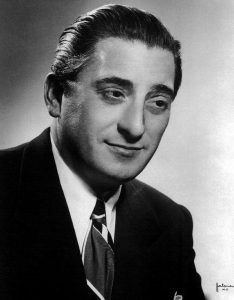
By Hurok Attractions-photographer:Halsman, New York (eBay item photo front photo back) [Public domain], via Wikimedia Commons
In 1932 he was hired as a tenor soloist with the Radio City Music Hall company. Thanks to its radio broadcasts and stage programs, Peerce soon had a nationwide following. This led to concert engagements, and then he made his operatic debut in May 1938 in Philadelphia as the Duke of Mantua in Rigoletto, followed by his first solo recital in New York in November 1939.
The legendary maestro Arturo Toscanini heard him and found him to be the tenor he had sought to sing operatic and choral works with the NBC Symphony Orchestra. The recordings made during, or following, the NBC broadcasts are among the outstanding musical legacies of our time. Toscanini was reportedly pleased with Peerce’s professionalism, as well as his extraordinary musical talents; many have said that Peerce may have been Toscanini’s “favorite tenor” during the Maestro’s 17 years at NBC.
Peerce made his debut with the Metropolitan Opera on November 29, 1941, singing Alfredo in Verdi’s La traviata. He sang also the parts of Cavaradossi in Tosca, Rodolfo in La bohème, and in Gounod’s Faust. He was hailed by the critics as the “All-American successor to the ‘greats’ of opera’s almost extinct ‘Golden Age.'” In 1946 he sang and recorded Puccini’s “Tosca” with soprano Grace Moore and baritone Lawrence Tibbett at the Met.
In 1943 he appeared in the OWI film, Hymn of the Nations, with Toscanini, the NBC Symphony Orchestra, and the Westminster Choir in a performance of Verdi’s seldom-heard choral work. Filmed in NBC Studio 8-H, the performance has been issued on video-cassette and DVD.
During the 1950’s Mr. Peerce performed regularly as a featured soloist before audiences of over 14,000 guests under the conductor Alfredo Antonini at the landmark Lewisohn Stadium in New York City. These Italian Night open air concerts featured the Philharmonic-Symphony Orchestra and the Lewisohn Stadium Orchestra along with such operatic luminaries as Richard Tucker, Robert Merrill, and Eileen Farrell.
In 1956 Peerce made a sensation in Moscow as a musical “cultural exchange” ambassador, being the first American to sing with the famed Bolshoi Opera. He remained on the roster of the Metropolitan until 1966, appearing again in 1966-1967. He also taught a master class. In 1971 he made his Broadway debut as Tevye in “Fiddler on the Roof.” He continued to make occasional appearances until his retirement in 1982, remaining in fine voice. He was the brother-in-law of fellow Jewish-American tenor Richard Tucker. Peerce was also at home on the concert stage and in solo recital.
Peerce recorded almost exclusively for RCA Victor as a “Red Seal” artist. Among his first recordings was as a featured soloist in Nathaniel Shilkret’s 1939 tribute album to Victor Herbert. That same year Peerce was the tenor soloist in Toscanini’s broadcast concert of Beethoven’s Ninth Symphony, but it would be years before the Maestro would approve one of his performances of that symphony for commercial release.
Peerce sang in Toscanini’s 1944 broadcasts of Beethoven’s Fidelio, followed by the complete performances of Verdi’s La traviata, Puccini’s La bohème, and Verdi’s Un ballo in maschera (with Herva Nelli), all eventually released on LP and CD. (Peerce did not sing in Toscanini’s broadcasts of Verdi’s Otello, Aida, or Falstaff.) He also sang in the Madison Square Garden concert in 1944, which featured the final act of Rigoletto with Toscanini conducting the combined New York Philharmonic and NBC Symphony Orchestra; this performance was recorded and also released on LP and CD. In 1952, he participated in Toscanini’s last performance of Beethoven’s Ninth Symphony, which the Maestro finally allowed to be released commercially on the RCA Victor label. His best-selling recording, however, was of a popular song, The Bluebird of Happiness.
He made several stereophonic recordings in the 1950s and 1960s for RCA, then gradually curtailed his recording projects. Most of his major recordings have been released on CD.[13]
For Columbia Masterworks Records, Peerce sang the title role in a 1963 recording of selections from Sigmund Romberg’s The Student Prince, opposite Roberta Peters, and also featuring Giorgio Tozzi. This has not yet been released on CD.
He died December 15, 1984 in New York City.
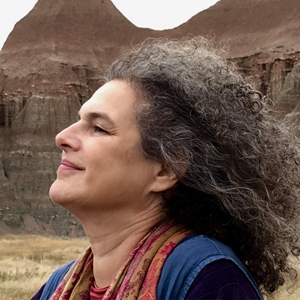 Orit Perlman, Cantorial soloist, singer of Jewish music and composer.
Orit Perlman, Cantorial soloist, singer of Jewish music and composer.
Studied at U of Minnesota, Tel-Aviv Music Academy and Haifa University.
Graduated HUC Jerusalem program for Israeli cantorial soloists directed by Cantor Professor Eliyahu Schleifer.
Specialized in cantorial singing with Hazzanit Michal Schiff-Matar and Hazzan Chayim Pfeifel.
Coaches vocal training since 2000, including in in Afula conservatory.
Orit has been serving families and congregations in Israel and the United States since 1995 as prayer leader of Shabbat, High Holidays, and life cycle ceremonies, particularly as officiator of bar mitzvah and bat mitzvah ceremonies as well as weddings and funerals.
These include HUC Jerusalem, Moreshet Yisrael, Mevakshei Derekh , Kol Haneshama ,Tsur Hadasa (Jerusalem), Yedid Nefesh (Carmiel), Ohel Avraham, Or Hadash, Moriah Congregation in Haifa, Rodef Shalom (Waco Texas).
Since 2002 officiating ceremonies at Sulam Yaakov (Zichron) as well as creative ceremonies for Israelis and Americans coming to celebrate in Israel, and since 2010 serves as a High Holiday cantor in Beth Hillel Temple in Kenosha Wisconsin.
Music publication and awards
She is a published award winning composer of new Jewish music. Rosh Chodesh Song, published in anthology A Season of Singing by Sarah M. Ross, Brandeis University Press 2016
Six time recipient of Shalshelet 2007, 2010 festival awards.
Published in Transcontinental Music 4th and 5th Shabbat Anthologies.
Her composition “Bli Kol“, text by poet Dana Amir, for violin, viola, cello and voice received Honorary mention for 2012-2013 Itai Weiner Composition award through Haifa University.
Soon to be published in WCN‘s Kol Isha anthology.
Workshops
Created workshop: Shalom Aleichem and My Angel, writing creative prayer and poetry influenced by Jewish melodies and modern Hebrew texts, at times with Juditta Ben-David.
Created workshop and “Tfilotai” cd in collaboration with HUC Jerusalem for educators and families on the topic of prayer. This workshop was given to childhood educators through BJE of greater Houston
Performs and gives workshops on the topic of prayer and congregational Jewish melodies in Israel and in the United States, was given at CAJE 2003.
Performance
From 2001, traditions of Jewish music .
Created “Shirat Hamamot”, collection of women’s song and story, performs with singer Idit Eshel.
Performs with ladino musicologist Dr. Susana Weich Shahak, at Bar-Ilan University, and Teatron Inbal, Mercaz Gaon, Cervantes Institute and other venues connected to the Autoridad Nasionala del Ladino i su Kultura.
Ladino performances at Rappaport Auditorium, Hecht Auditorium, Studio theater, National Library.
Accompanying musicians have been Ariel Qassis, Idan Toledano, Yaniv Rabba
currently are Yarden Erez, Zeev Yaniv.
Performs Yiddish and created Ot Azoi! Cd with arranger, sound recorder and pianist Itay Alter, at Beit Leyvik, Yung Yiddish, Beit Avi Chai they were on national television and radio.
Performs favorite songs from the 70’s with Boaz Sternberg.
Performs with poet Yehonadav Perlman.
As well as composed and performed original music for poetry of Navit Barel, Smadar Imor, Dana Amir, Rachel Asharov, Ilana Tsimchoni, and Binyamin Alkobi at various venues and at Metullah poetry festival.
Wrote and performed stories interspersed with cantorial singing “Sipura shel Chazanit”
Classical singing
Soloist for choirs “Gitit” and “Zamarei Hamadregal”.
Forest Song – German Lieder, with Tavor Gochman.
Choir: In 2006 directed choir of “Moriah” conservative synagogue.
Lecture/performances: Ladino Life Cycle Song, and Yiddish and Chazanut – Mutual Influences.
Original and new renditions of traditional Jewish music with Boaz Sterenberg and Yair Smoilov,
Haviva Ziv on Santur and Tabla in the duo Zimrat Ya, with Udi Kazmirsky in jazz band Niggun Atik.
Academic and creative writing
Article: Yechiel Mechel Perlman: The Enterprise of a Musician, published by Haifa University, 2017.
Lyrics for composition Travel Song of a Moth, edited libretto and wrote aria lyrics for the modern opera Esther by Rachel Yazkan.
Poetry won prizes, 1st, 3rd and honorary mentions at Reuben Rose Poetry Competition, and honorary mention Chester H. Jones Foundation,
Wrote, composed and performed 20 minute solo perfomance”Bereishit” at Hakhel festival.
Discography
Upcoming: “Songs of Tetuan” – project of Dr. Susanna Weich-Shahak
2015 – Haifa Awakens from a Dream –project of Haifa University, songs about Haifa: Ir Yalduti (words and music) Shabbat Yoredet al ha’Ir Haifa (music, words Yehonadav Perlman)
2011 – “M’ayin Yavo” – original music for Jewish spirituality
2011 – Ventanas Altas de Saloniki – western and eastern traditions, a double disk, under the musical direction of Dr. Suzanna Weich-Shahak, project of Haifa University,
2010 – “Ot Azoi” – Yiddish folk music with a new interpretation, in partnership with Itay Alter
2008 – Tfila shebaLev, Kabbalat Shabbat of “Ohel Avraham” together with other congregants, led by Rabbi Ofek Meir
2006 – “Tfilotai” – Hebrew prayer for family, in collaboration with HUC Jerusalem, with Boaz Sterenberg and Yaniv Smoilov
2004- “Zimrat Ya” with Haviva Ziv
2002- “Niggun Atik” with Udi Kazmirsky
Photo Credit: Janet Bayliss
Joseph Rosenblatt
1882 – 1933
 Yossele Rosenblatt was born on May 2nd 1882 in Biela Tserkov, in the Ukraine. He came from a long line of Chazanim and his father was a cantor in Kiev.
Yossele Rosenblatt was born on May 2nd 1882 in Biela Tserkov, in the Ukraine. He came from a long line of Chazanim and his father was a cantor in Kiev.
Yossele sang from a very early age. He became a member of his father’s choir and was soon declared to be a ‘wunderkind,’ travelling throughout the Austro-Hungarian Empire, performing at countless synagogues.
At the age of 12 he met Taubele Kauffman and at the age of 18 Yossele married her and soon after accepted the position of Cantor at Muncaz in Hungary. This position he obtained against the competition of 40 other Chazanim.
From there he went to Pressburg, where he officiated for five years and during this period, he began to publish his numerous synagogal compositions.
He then stayed for six years in Hamburg and, according to his account, tried to run away to America. However he was ‘overtaken on the steamer and brought back like a criminal.’ (!)
When he eventually did arrive in the States in 1912, he was immediately engaged by the Congregation Ohab Zedek in New York and his fame soon grew. He recorded for various phonograph companies and this undoubtedly was influential in ensuring that his name spread all over the country.
After appearing in a particularly successful concert in Chicago, Yossele was offered $1000 per night to sing in opera. However, so great was his love for Yiddishkeit, that he turned it down.
In 1922 he was persuaded to enter into a business deal that left him bankrupt. This forced him to give up the pulpit and concentrate on concertising, in which there was the opportunity for him to make much larger sums of money, and so he made extensive tours, including coming to Europe.
In 1927 Warner Brothers offered Rosenblatt $100,000 to co-star with Al Jolson in ‘The Jazz Singer,’ but they could not persuade him to sing Kol Nidrei. He felt that it was much too sacred to be used as entertainment.
In 1928 he was engaged by the Anshei Sfard Congregation in Brooklyn and was paid $12,000 a year, the highest salary paid at that time to any Cantor.
Rosenblatt was delighted to be offered the chance to film in the Holy Land by the Palestine-American Fox Film Co. Although he was earning a good salary, he was still paying off the debts of his bankruptcy and, when he arrived in Palestine, in 1933, he was virtually penniless.
Sadly, on June 19th 1933 he was stricken by a heart-attack at the age of only 51. His funeral service was conducted by Chief Rabbi Kook and attended by more than 20,000 people.
Rosenblatt recorded about 180 compositions, most of which were his own.
© Rabbi Geoffrey Shisler
Benedict Silberman
1901 – 1971
Benedict Silberman, originally Boruch Hirsch-Benedigton Silberman (December 5, 1901 Helsinki, Finland – December 11, 1971 Hilversum, Netherlands), was a Dutch composer and conductor of Austrian Jewish descent.
Silberman was the son of an Austrian violinist working in Helsinki who settled in Amsterdam. Silberman studied piano with Jean-Baptiste de Pauwand composition with Sem Dresden at the Amsterdam Conservatory. He wrote a piano concerto (1924) at the end of his studies. A year later he composed a violin concerto. He left for Berlin where he played as a violinist and arranged light classical musical, preferentially Viennese operettas. In 1944 he composed his own operetta Het Rozeneiland (The Island of Roses). He had contact with Franz Lehár, Robert Stolz and Emmerich Kálmán and toured Europe with the dance orchestras of Paul Godwin, Marek Weber and Dajos Bela.
In 1936 he returned to the Netherlands and became pianist in the AVRO radio orchestra of Kovacs Lajos. In 1938 he became conductor of the VARA radio orchestra. In 1948 he was asked to create a radio orchestra specialized in light classical music; he led this Promenade Orkestfrom 1949 till 1967. In 1965, he won the Golden Harp for his contributions to Dutch music.
in 1965 Shlomo Carlebach published the album in the palace of the king, Silberman arranged and conducted the chorus and symphony orchestra.
Golda Tencer
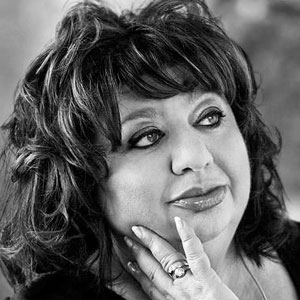 Gołda Tencer is a Polish-Jewish actress and singer. Gołda Tencer was born to a Jewish family, the daughter of Szmul and Sonia Tencer. In 1971 she graduated from Actors Studio in Warsaw. In 1984, as a scholar of the United States government, she explored theater life in U.S
Gołda Tencer is a Polish-Jewish actress and singer. Gołda Tencer was born to a Jewish family, the daughter of Szmul and Sonia Tencer. In 1971 she graduated from Actors Studio in Warsaw. In 1984, as a scholar of the United States government, she explored theater life in U.S
Filmography
- 2007: Liebe nach Rezept – as Rosha
- 2004: Alles auf Zucker! – as Golda Zuckermann
- 1985: War and Love
- 1983: The Winds of War
- 1983: Haracz szarego dnia – as Róża
- 1982: Hotel Polan und Seine Geste – as miss Menasze
- 1982: Austeria – as Blanka
- 1979: Komedianci
- 1979: Gwiazdy na dachu
- 1979: Dybuk – as Lea
- 1979: Doktor Murek – as Kapelewicz’s daughter
- 1979: David
Songs
- A Yiddishe Mame
- Ballady i romanse
- Bei Mir Bistu Shein
- Cadikim
- Dieta
- Dudele
- Ejli, Ejli
- Fraytik Oyf Der Nakht
- Josl, Josl
- Kinder Jorn
- Mein Jidishe Mame
- Mein Shtetele Belz
- Rebeka
- Rebns Nysn
- Rozinkes mit Mandlen
- Sekrety drzew
- Varnitshkes
- Zemerl
1984, as a scholar of the United States government, she explored theater life in U.S
Yaffa Yarkoni
 In Israel she is known simply as “Yaffa.” Her songs have exhilirated the nation from its very inception – especially in times of war. She was nicknamed “the singer of the wars” and for many Israelis Yaffa became the apotheosis of patriotism
In Israel she is known simply as “Yaffa.” Her songs have exhilirated the nation from its very inception – especially in times of war. She was nicknamed “the singer of the wars” and for many Israelis Yaffa became the apotheosis of patriotism
Singer Yaffa Yarkoni was born in Eretz, Israel more than two decades before the realization of a Jewish state. She began her career in a coffee house owned by her mother. Yaffa served as a radio operator in Israel’s War of Independence in 1948 and became popular singing the songs adopted as anthems by the Palmach, the Jewish underground militia that fought the British and the Palestinians in the pre-state days.
In 1967, after Israel captured Jerusalem’s Old City, it was Yaffa who sang Jerusalem of Gold in front of the Western Wall, Judaism’s holiest site – an event that remains indelibly etched into the minds of an entire nation. And on Israel’s 50th Independence Day, in 1998, she was awarded the prestigious Israel Prize for her contribution to the nation’s music.
In Israel Yom Hatzmaut, or Independence Day, falls on 5 Iyar. The day before is Yom Hazikaron or Remembrance Day – the equivalent of Memorial Day in the U.S.A. (In 2002 these would fall on 16 and 17 April). For each of the past 54 Memorial Days Yaffa has been onstage, singing patriotic songs to honor the fallen soldiers of Israel. For Yaffa, even at age 76, Yom Hazikaron 2002 promised to be more of the same. There was to be a performance in Kfar Yona and then she would appear at her granddaughter’s school in Givatayim. And just two weeks later a gala tribute in Yaffa’s honor was due to take place – an evening almost two years in the making
In the United States following the tragedy of the World Trade Center, comedian Bill Maher, host of Politically Incorrect, made comments that nearly cost him his job. The U.S. administration, rather than defend Maher’s right of free speech, actually responded by saying all Americans need to watch what they say and do. Yaffa Yarkoni found that Israel and the United States have this much in common.
A couple of days before the Independence/Remembrance Day celebrations, Yaffa was interviewed on Israeli Army Radio. But rather than the expected exhortation to the troops, Yaffa Yarkoni – the singer of the wars – dissented. Having seen video and pictures from the Israeli incursions into Jenin, Bethlehem, and Ramallah Yaffa had this to say:
When I saw the Palestinians with their hands tied behind their backs, young men, I said, ‘It is like what they did to us in the Holocaust.’ We are a people that lived through the Holocaust. How can we be capable of such things?
Yaffa went on to say she understood why some Israeli reserve soldiers refused to serve in the West Bank and Gaza, and revealed that one of her sons-in-law is among them. She also said if the situation in Israel continued to deteriorate she would seriously consider sending her grandchildren to live abroad.
The firestorm that followed her words was fast and merciless. Callers deluged talk radio shows, editorials condemned her, government ministers denounced her. Yaffa’s words were deemed so offensive that the union representing the nation’s performing artists called off the planned tribute. The town of Kfar Yona canceled her Memorial Day performance. Youth movements declared a boycott of her music. She received so many hate calls and faxes that she was too frightened to appear in public.
Orit Shohat, Yaffa’s daughter, said the family is disappointed that so few Israeli artists have risen to her mother’s defense. One of her defenders is Gidi Gov, a well-known pop singer. Gov announced that he was quitting the Israeli Union of Performing Artists, the group that canceled its evening of tribute to Yaffa. But few others have spoken out publicly in her support.
Yaffa Yarkoni has recorded more than 60 record albums in numerous languages including Hebrew, French, English, and Spanish. She has toured the world several times.
Source: http://everything2.com

